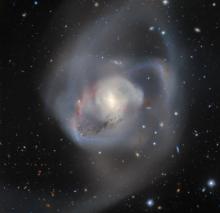Listen to today's episode of StarDate on the web the same day it airs in high-quality streaming audio without any extra ads or announcements. Choose a $8 one-month pass, or listen every day for a year for just $30.
You are here
Early Galaxies
James Webb Space Telescope started out with a bang. Some of its first pictures revealed that the universe was churning out galaxies quite soon after the Big Bang. That pushed the start of galaxy formation much earlier than most astronomers had expected.
The pictures revealed 87 galaxies that look like they formed just 200 million to 400 million years after the Big Bang, which took place 13.8 billion years ago. Astronomers are using other Webb observations to confirm those ages. If even a small fraction of them are correct, the ideas about early galaxy formation may need to be revised.
In a second study, scientists looked at Webb images of 850 galaxies that are at least nine billion light-years away. They compared the pictures to those of the same galaxies snapped by Hubble Space Telescope. Webb has a sharper view, and its instruments are more sensitive to the types of light at which astronomers observe distant galaxies.
Team members found that the Webb pictures showed much more detail in the most-distant galaxies. Many of them were shaped like disks, like our home galaxy, the Milky Way. Others were well-defined balls. That tells us that galaxies were pulling themselves together when the universe was quite young.
Webb’s first images covered only a tiny portion of the sky. So astronomers expect to find many more early galaxies as the telescope takes a deep look at the rest of the universe.
Script by Damond Benningfield





